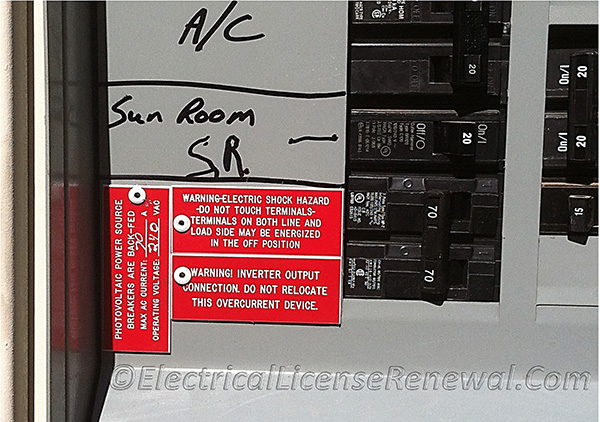705.12(D)(2) Bus or Conductor Ampere Rating.

Code Change Summary: The rules in 705.12(D)(2) have been completely rewritten and expanded significantly.
Before the 2014 code change, there was one basic rule when interconnecting a parallel power production source such as a utility interactive PV system to the premises wiring system: The sum of the ampere ratings of overcurrent devices in circuits supplying power to a busbar or conductor shall not exceed 120% of the rating of the busbar or conductor.
In the 2014 NEC®, there are many rules which address all possible types of interconnections to feeders, taps, busbars and even center-fed panelboards. One thing is common to all of the new interconnection rules: They all begin by using 125% of the inverter output current.
The inverter output current can be found on the inverter nameplate or by dividing the wattage of the inverter by the voltage which is more accurate since many inverters are compatible with several voltage configurations. The inverter output current value listed on the inverter nameplate is often based on the lowest voltage that the inverter is compatible with.
Example: A 7,000 watt utility interactive PV system string inverter (used at 240 volts).
- 7,000 W ÷ 240 V = 29 amps (continuous output current rating).
- 29 amps X 125% = 36 amps.
36 amps is the value to start with when applying the new interconnection rules in 705.12(D)(2).
Below is a preview of the NEC®. See the actual NEC® text at NFPA.ORG for the complete code section. Once there, click on the “free access” tab and select the applicable year of NFPA 70 (National Electrical code).
2011 Code Language:
705.12(D)(2) Bus or Conductor Rating. The sum of the ampere ratings of overcurrent devices in circuits supplying power to a busbar or conductor shall not exceed 120 percent of the rating of the busbar or conductor.
2014 Code Language:
705.12(D)(2) Bus or Conductor Ampere Rating. One hundred twenty-five percent of the inverter output circuit current shall be used in ampacity calculations for the following:
(1) Feeders. Where the inverter output connection is made to a feeder at a location other than the opposite end of the feeder from the primary source overcurrent device, that portion of the feeder on the load side of the inverter output connection shall be protected by one of the following:
(a) The feeder ampacity shall be not less than the sum of the primary source overcurrent device and 125 percent of the inverter output circuit current.
(b) An overcurrent device on the load side of the inverter connection shall be rated not greater than the ampacity of the feeder.
(2) Taps. In systems where inverter output connections are made at feeders, any taps shall be sized based on the sum of 125 percent of the inverter(s) output circuit current and the rating of the overcurrent device protecting the feeder conductors as calculated in 240.21(B).
(3) Busbars. One of the methods that follows shall be used to determine the ratings of busbars in panelboards.
(a) The sum of 125 percent of the inverter(s) output circuit current and the rating of the overcurrent device protecting the busbar shall not exceed the ampacity of the busbar.
Informational Note: This general rule assumes no limitation in the number of the loads or sources applied to busbars or their locations.
(b) Where two sources, one a utility and the other an inverter, are located at opposite ends of a busbar that contains loads, the sum of 125 percent of the inverter(s) output circuit current and the rating of the overcurrent device protecting the busbar shall not exceed 120 percent of the ampacity of the busbar. The busbar shall be sized for the loads connected in accordance with Article 220. A permanent warning label shall be applied to the distribution equipment adjacent to the back-fed breaker from the inverter that displays the following or equivalent wording:
WARNING: INVERTER OUTPUT CONNECTION; DO NOT RELOCATE THIS OVERCURRENT DEVICE.
The warning sign(s) or label (s) shall comply with 110.21(B).